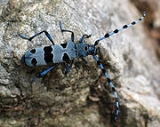
Rosalia longicorn
Encyclopedia
The Rosalia longicorn is a large longicorn (family Cerambycidae) that is distinguished by its distinctive markings.
 The Rosalia longicorn is 15 to 38 mm long. The antennae can be up to twice as long as the rest of the body in males, and the same length in females. The elytra
The Rosalia longicorn is 15 to 38 mm long. The antennae can be up to twice as long as the rest of the body in males, and the same length in females. The elytra
are flat, blue-gray, with variable black spots, including a prominent one on the thorax
, a silky one in front, and a small one in back. Both the antennae and the legs have the same coloration as the body. The coloration serves as good camouflage
with their preferred habitat, the European Beech
.
They are distributed from the Alps
east to Slovakia
. Its numbers across Europe has greatly depleted in recent years, and it is a protected species in Germany, Hungary, Poland and Slovenia.
The adults are active from June to September. By day the beetles sit near flowers and feed on the pollen
. They make a chirping sound by scraping their rear legs and elytra together. After mating, the female lays the eggs within a crack in the bark of a beech. The larva
e eat the bark and pupate there as well when it has reached about three years of age. The mature adult emerges from the pupa.
Description

Elytron
An elytron is a modified, hardened forewing of certain insect orders, notably beetles and a few of the true bugs ; in most true bugs, the forewings are instead called hemelytra, as only the basal half is thickened while the apex is membranous...
are flat, blue-gray, with variable black spots, including a prominent one on the thorax
Thorax
The thorax is a division of an animal's body that lies between the head and the abdomen.-In tetrapods:...
, a silky one in front, and a small one in back. Both the antennae and the legs have the same coloration as the body. The coloration serves as good camouflage
Camouflage
Camouflage is a method of concealment that allows an otherwise visible animal, military vehicle, or other object to remain unnoticed, by blending with its environment. Examples include a leopard's spotted coat, the battledress of a modern soldier and a leaf-mimic butterfly...
with their preferred habitat, the European Beech
European Beech
Fagus sylvatica, the European Beech or Common Beech, is a deciduous tree belonging to the beech family Fagaceae.-Natural range:...
.
They are distributed from the Alps
Alps
The Alps is one of the great mountain range systems of Europe, stretching from Austria and Slovenia in the east through Italy, Switzerland, Liechtenstein and Germany to France in the west....
east to Slovakia
Slovakia
The Slovak Republic is a landlocked state in Central Europe. It has a population of over five million and an area of about . Slovakia is bordered by the Czech Republic and Austria to the west, Poland to the north, Ukraine to the east and Hungary to the south...
. Its numbers across Europe has greatly depleted in recent years, and it is a protected species in Germany, Hungary, Poland and Slovenia.
The adults are active from June to September. By day the beetles sit near flowers and feed on the pollen
Pollen
Pollen is a fine to coarse powder containing the microgametophytes of seed plants, which produce the male gametes . Pollen grains have a hard coat that protects the sperm cells during the process of their movement from the stamens to the pistil of flowering plants or from the male cone to the...
. They make a chirping sound by scraping their rear legs and elytra together. After mating, the female lays the eggs within a crack in the bark of a beech. The larva
Larva
A larva is a distinct juvenile form many animals undergo before metamorphosis into adults. Animals with indirect development such as insects, amphibians, or cnidarians typically have a larval phase of their life cycle...
e eat the bark and pupate there as well when it has reached about three years of age. The mature adult emerges from the pupa.

